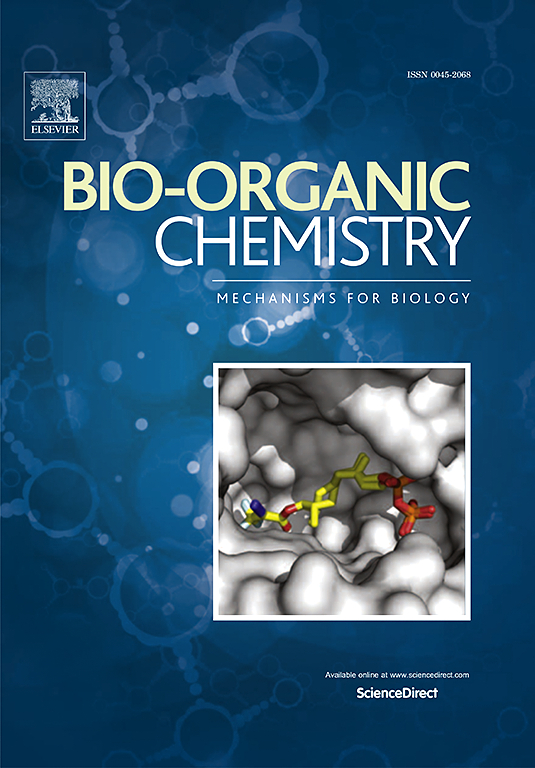Targeting Autotaxin with imidazole- and Triazolyl-based inhibitors: Biological insights from in vitro and in vivo studies in pulmonary fibrosis
IF 4.5
2区 医学
Q1 BIOCHEMISTRY & MOLECULAR BIOLOGY
引用次数: 0
Abstract
Autotaxin (ATX) is a key enzyme in producing lysophosphatidic acid (LPA), a lipid involved in fibrosis. This study reports the synthesis and evaluation of novel ATX inhibitors containing zinc-binding imidazole or triazole motif with piperidine spacers. Compound 27a exhibited strong ATX inhibition (IC50 = 39 nM) in human plasma and demonstrated efficacy in cellular and animal fibrosis models. In vitro ADME/T studies showed favorable liver microsomal stability, minimal hERG binding, and acceptable PK parameters. In vivo, 27a significantly reduced plasma LPA levels and downregulated fibrosis-related pathways, including p-ERK, p-P38, and p-JNK. It also inhibited cell migration and collagen gel contraction without cytotoxicity in fibrotic cells. In a bleomycin-induced pulmonary fibrosis model, 27a reduced collagen deposition, LPAR1, and p-ERK expression, while decreasing mRNA levels of α-SMA, Col1A1, and pro-inflammatory markers IL-6, IL-1β, and INFγ. These findings position 27a as a promising ATX inhibitor with therapeutic potential for fibrosis-related diseases.

以咪唑和三唑基抑制剂靶向Autotaxin:来自肺纤维化体外和体内研究的生物学见解
Autotaxin (ATX)是产生溶血磷脂酸(LPA)的关键酶,LPA是一种参与纤维化的脂质。本研究报道了含锌结合咪唑或三唑基序和哌啶间隔的新型ATX抑制剂的合成和评价。化合物27a在人血浆中表现出较强的ATX抑制作用(IC50 = 39 nM),并在细胞和动物纤维化模型中显示出疗效。体外ADME/T研究显示良好的肝微粒体稳定性,最小的hERG结合和可接受的PK参数。在体内,27a显著降低血浆LPA水平,下调纤维化相关通路,包括p-ERK、p-P38和p-JNK。它还能抑制细胞迁移和胶原凝胶收缩,对纤维化细胞无细胞毒性。在博莱霉素诱导的肺纤维化模型中,27a减少了胶原沉积、LPAR1和p-ERK的表达,同时降低了α-SMA、Col1A1和促炎标志物IL-6、IL-1β和INFγ的mRNA水平。这些发现表明27a是一种有前景的ATX抑制剂,具有治疗纤维化相关疾病的潜力。
本文章由计算机程序翻译,如有差异,请以英文原文为准。
求助全文
约1分钟内获得全文
求助全文
来源期刊

Bioorganic Chemistry
生物-生化与分子生物学
CiteScore
9.70
自引率
3.90%
发文量
679
审稿时长
31 days
期刊介绍:
Bioorganic Chemistry publishes research that addresses biological questions at the molecular level, using organic chemistry and principles of physical organic chemistry. The scope of the journal covers a range of topics at the organic chemistry-biology interface, including: enzyme catalysis, biotransformation and enzyme inhibition; nucleic acids chemistry; medicinal chemistry; natural product chemistry, natural product synthesis and natural product biosynthesis; antimicrobial agents; lipid and peptide chemistry; biophysical chemistry; biological probes; bio-orthogonal chemistry and biomimetic chemistry.
For manuscripts dealing with synthetic bioactive compounds, the Journal requires that the molecular target of the compounds described must be known, and must be demonstrated experimentally in the manuscript. For studies involving natural products, if the molecular target is unknown, some data beyond simple cell-based toxicity studies to provide insight into the mechanism of action is required. Studies supported by molecular docking are welcome, but must be supported by experimental data. The Journal does not consider manuscripts that are purely theoretical or computational in nature.
The Journal publishes regular articles, short communications and reviews. Reviews are normally invited by Editors or Editorial Board members. Authors of unsolicited reviews should first contact an Editor or Editorial Board member to determine whether the proposed article is within the scope of the Journal.
 求助内容:
求助内容: 应助结果提醒方式:
应助结果提醒方式:


